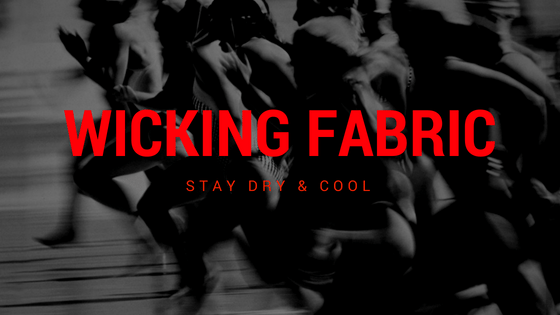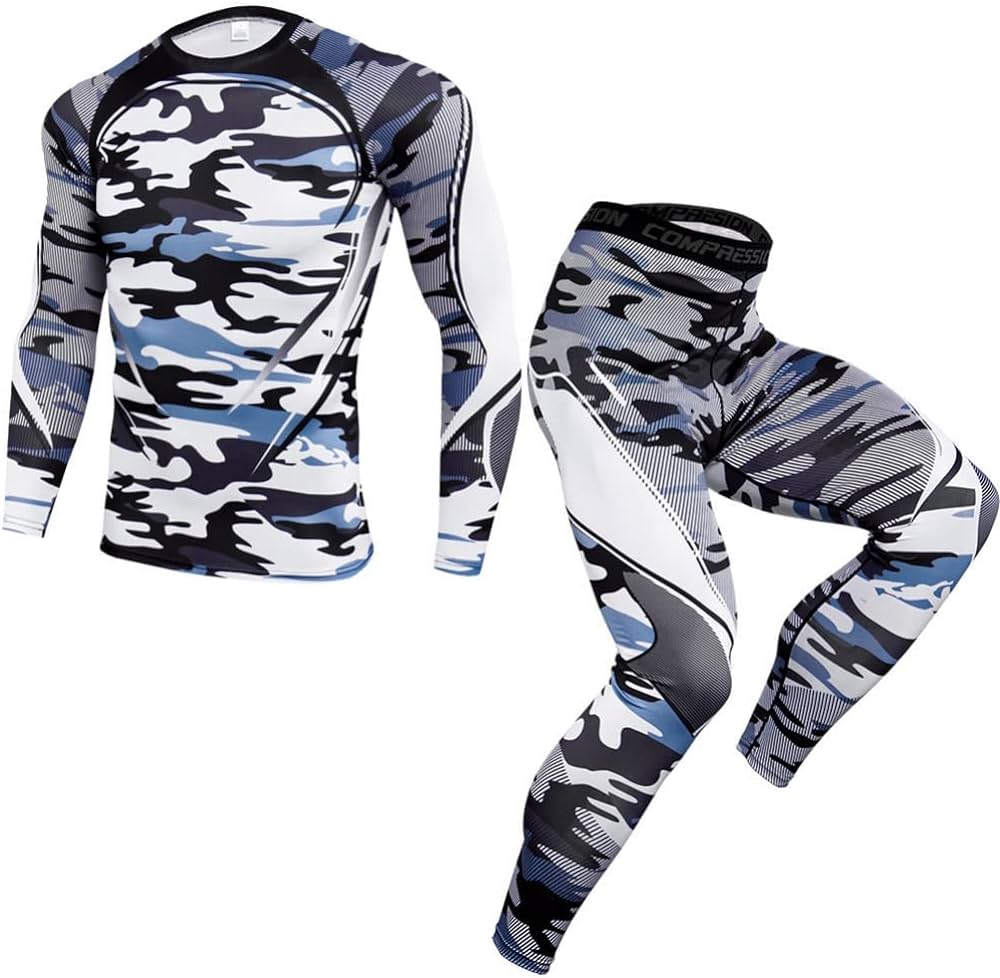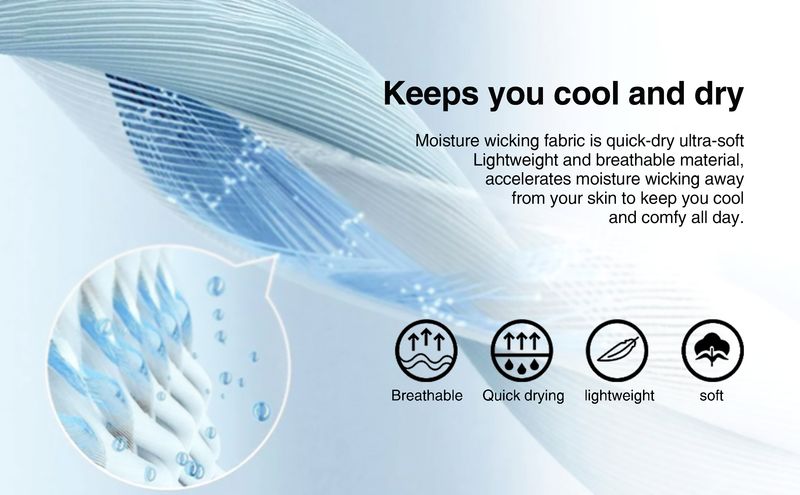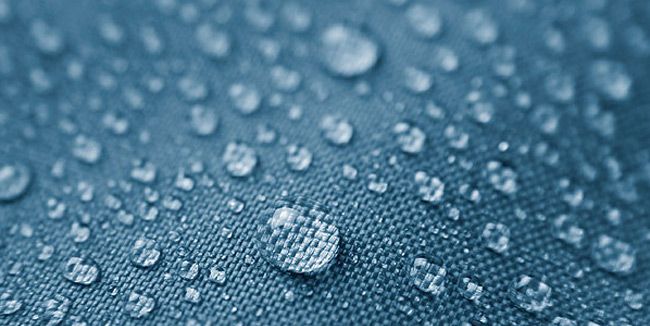Clothing designed for exercise and outdoor activities has come a long way in recent decades. One key advancement has been the development of moisture-wicking and quick-dry fabrics.
If you sweat a lot or participate in water sports, these high-tech fabrics can make all the difference in comfort.
But with so many options out there, how do you choose?
What exactly do terms like “moisture wicking” even mean? And what fabrics work best?
In this video, we’ll give you a complete guide to understanding moisture-wicking and quick dry fabric clothing.
We’ll start by explaining what defines these fabrics and why they’re useful.
Then we’ll compare different moisture-wicking fabric options—including both natural and synthetic fibers.
We’ll also give care and washing tips to help your athletic apparel last.
So, let’s dive in!
Sweat pouring down your face. Heart pounding. Legs burning as you push to sprint the last mile. But suddenly you feel a chill creep over your soaked shirt and shorts. Within minutes, you’re shivering instead of charging ahead to crush your new PR.
We’ve all experienced that bone-chilling sensation when drenched workout wear betrays us. The damp cotton plastered against our skin eventually turns our sweat against us!
But what if a special kind of fabric could whisk away sweat, keeping it from ever accumulating next to your body in the first place?
And what if those fabrics then dried in mere minutes rather than heavy, clinging hours?
These are what we call Moisture-wicking and Quick-dry fabrics.
With the right high-tech moisture-wicking and quick-dry activewear, you won’t suffer the consequences of sweat-drenched clothing again.
These fabrics offer a breathable, comfortable barrier between your hard-driving intensity and the havoc all that perspiration can wreak.
So, if you’re intrigued by what modern fabric engineering can do?
Or curious about exactly how moisture-wicking works its magic?
Then, you’ve come to the right place!
In this complete guide, we’ll give you an insider’s look into cutting-edge moisture-wicking and quick-dry fabrics for athletic apparel.
Let’s get started!
What is Moisture Wicking Fabric?
First question: What exactly makes a moisture-wicking fabric? Simply put, these fabrics move sweat and moisture away from your skin to the fabric’s outer face. The moisture then evaporates instead of absorbing into the material. This keeps you drier compared to fabrics like cotton that soak up perspiration.
Moisture-wicking ability relies on a physical process called capillary action. Have you ever noticed how water seems to defy gravity as it climbs up a paper towel? That’s capillary action at work. It allows liquids to flow through the tiny spaces in certain materials.
In moisture-wicking fabric, the spaces between the fabric’s fibers form miniature channels. As sweat meets the fabric, it gets drawn into these channels and propelled outward. So rather than just getting absorbed right at the skin’s surface, the moisture gets transported away.
Now…
What Is Quick Dry Fabric?
Similarly, a quick dry fabric is engineered to do exactly what the name promises—dry rapidly. Of course, moisture wicking helps speed up drying already. But quick-dry fabrics take things even further through fabric construction and special coatings.
Quick dry fabrics usually have a loose-knit or breathable weave. This allows fresh air to pass through easily and evaporate moisture. Many also have durable water-repellant (DWR) finishes or other coatings. These treatments cause water to bead up and roll right off the fabric.
Between moisture-wicking, breathable construction, and water-repelling finishes, quick dry fabric dries 50% faster than even cotton. For high-energy activities, that means you stay comfortable even when you work up a major sweat. No one wants clammy, wet clothes plastered to them for the rest of a bike ride or run!
How to Achieve Moisture Wicking and Quick Drying Fabrics
When researching athletic apparel, you’ll probably encounter mentions of moisture-wicking and quick-dry fabric technologies. But have you ever wondered how fabrics gain these useful performance properties? Achieving effective moisture wicking relies on two key factors:
First, a strong capillary action to pull moisture along the fabric’s fibers.
And second, a construction that enables rapid evaporation of that moisture outward.
There are a few main methods manufacturers use to build fabrics with these traits:
Specialized chemical finishes are very common. Applying hydrophobic treatments makes a fabric resist absorbing sweat while hydrophilic finishes help draw moisture outward. These can be applied to just one face of fabric or different finishes on either side to enhance the pull of moisture in one direction.
Plasma treatments are another technique. This exposes the fabric to plasma gases under very precise conditions to alter fiber surfaces. It can make them either attract or resist moisture. The effects gradually fade over time though.
Finally, structural fabric design itself plays a role too. Using different weaves or knits, weights, and fiber blends controls absorption and airflow. For example, a double-layer mesh fabric with larger holes facing the body but tighter mesh outside optimizes outward moisture movement and evaporation.
Synthetic and wool blends excel at moisture-wicking thanks to smooth fiber shapes that resist absorbing liquids. But specific processing enhancements take things even further. For instance, creating ridges, grooves, curves, or chambers in fabric surfaces gives moisture channels to follow outward.
In the best athletic fabrics, structural design works together with specialized chemical finishes and plasma treatments. This multi-step approach ensures effective moisture-wicking sweat after sweat, wash after wash.
What textile testing machine can test Moisture Wicking and Quick Drying Fabrics?
You can choose the SmartDry Dry Rate Tester. It is equipped with high-precision temperature sensors, wind speed sensors precision water dripping devices, etc., which can quickly simulate the process of human sweating and quickly determine the drying rate of textiles. The specially designed parallel cross-flow fan makes the wind speed more uniform and smooth, which can restore the actual evaporation process and make the test results more reliable. SmartDry is a smart instrument, that can be connected to the SmarTexLab app installed in the smartphone through WIFI so that the parameters can be set remotely and the test process can be monitored, which greatly improves the working efficiency. SmartDry applies to the AATCC 201 standard.
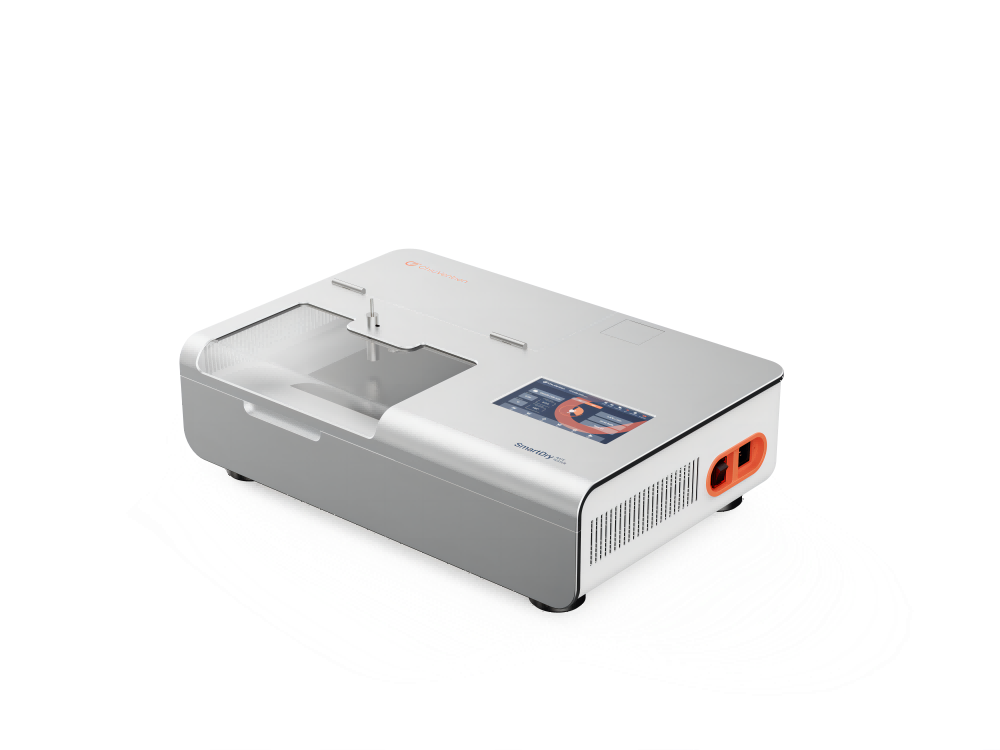
A test sample is placed on top of a heating plate at a constant temperature of 37° (99°F), and a certain amount of water rises from the bottom of the instrument to the center of the plate and saturates the sample. An anemometer inside the instrument dries the sample. An infrared temperature sensor measures the change in temperature of the sample to determine if the drying is finished, and then the drying speed is determined by the test drying time.
Smart instrument
This drying rate tester can be networked with a smartphone, so you can set parameters and monitor test status remotely, directly get test results and equipment warning alerts, etc.; Besides, you can share the test results with others.
Efficient convenient, and more reliable test
With a high-precision temperature sensor, wind speed sensor, and precision drip device, you can complete the test of drying rate quickly in 10 minutes.
The specially designed parallel cross-flow fan makes the wind speed more uniform and smooth, which can display the actual evaporation process and make the test results more reliable.
Simple and easy to use
The whole test process will be displayed on the screen and presented as a clear data curve.
Precise appearance design, aluminum alloy hard oxidation surface, durable and easy to clean; seven-inch color touch screen is easy to use.
What Are the Benefits of These Fabrics?
Now that we know how they work, what makes moisture-wicking and quick-dry fabrics so great? Well, there are several key advantages:
Stay Dry & Comfortable
The main benefit is simple—you stay drier as sweat wicked away from your skin evaporates. This keeps you feeling more comfortable even during intense exercise. Without moisture-wicking performance, sweat would just pool at the skin’s surface leading to that chilled, damp feeling as it eventually evaporates.
By keeping you drier, these fabrics also prevent chafing. No one wants that awful rash from skin rubbing together!
Regulate Body Temperature
The moisture-wicking fabric also helps regulate body temperature more effectively. As sweat evaporates from the skin, it has a cooling effect. This is your body’s natural process for preventing overheating. Quick-wick fabrics allow sweat to evaporate faster, enhancing this natural cooling system.
Hide Sweat Marks
Let’s be honest, big sweat stains on your shirt can be embarrassing! Moisture-wicking fabrics draw that perspiration through to the outer face of the fabric where it evaporates instead of setting into noticeable marks.
Fight Odor
The bacteria that cause body odor thrive in the moist environment sweat creates next to your skin. By transporting moisture away and evaporating it rapidly, moisture-wicking performance also reduces odor. Your gear will stay fresher between washings.
Prevent Chills
After an intense workout, your skin and clothes will be soaked no matter what. But moisture-wicking fabric helps limit this saturation so sweat doesn’t stick next to your skin as it slowly evaporates. This prevents that clammy post-workout chill.
Which Fabrics Can Wick Moisture?
Now the question you have all been waiting for is, which fabrics are moisture-wicking? There are a few options…
Synthetic Fabrics
Most purpose-designed moisture-wicking activewear contains at least some synthetic material, usually polyester or nylon. The plastics used to produce these fabrics form long, smooth fibers that naturally resist absorbing moisture.
Instead of penetrative wetting, water droplets rest on top of the fibers. So rather than soak in, sweat gets drawn along between the fibers through capillary action into the outer layers of fabric. From there it evaporates rapidly.
Many synthetics like polyester are also inherently quick-drying because they’re less affected by water exposure.
So synthetics check both boxes for moisture wicking and quickness to dry.
Moisture Wicking Fabric Spotlight: Polyester and Nylon
By now, you know that synthetic fabrics often make excellent moisture-wicking athletic apparel. And two of the most widely used are polyester and nylon.
Let’s take a closer look at what gives these fabrics their performance advantages—and a few disadvantages too.
First up is polyester, also called by brand names like Terylene. Thanks to smooth, hydrophobic fibers, polyester resists absorbing moisture. Instead, sweat glides along the fibers to the fabric surface rather than sinking in. This wicking action happens pretty quickly.
Beyond moisture management, polyester offers a few other useful traits like shape retention. Even after sweaty workouts, polyester activewear maintains its fit with minimal shrinking or warping compared to cotton. Resilience against wrinkles makes it a good choice for travel outfits too. It also earns high marks for durability and abrasion resistance.
However, polyester does have some downsides. Its slippery fiber surface can create problems with static cling. Ever peeled off a poly workout tank, only to have it stick right back to you? Annoying!
Nylon shares many of polyester’s advantages, along with a few unique benefits. Brands market types like tactical nylon for its extreme tear resistance. That rugged durability makes nylon garments withstand even intense activities. Along with strong sweat-wicking, nylon’s smooth, synthetic fibers offer excellent elasticity and recovery too.
But all those benefits come with some significant weaknesses as well. Nylon ranks lower on abrasion resistance compared to polyester, making it prone to pilling fuzz balls with friction. Its elasticity also makes nylon stretch out easier, potentially sagging into shapelessness over time.
Additionally, nylon has poor dimensional stability in heat. Leaving workout wear in a hot car or machine drying can warp seams and distort the fit. No one wants saggy gym shorts that don’t stay in place during squats!
Wool
Interestingly, wool also offers excellent natural moisture-wicking performance. Individual wool fibers have a protective outer sheath but contain lots of air pockets inside. So instead of absorbing moisture entirely into their cores, it flows through the fibers’ empty spaces. From here it similarly gets transported outward where it evaporates.
The downside is wool’s bulkiness reduces its drying speed. But otherwise, wool nicely complements synthetics as a moisture-wicking fabric.
What Fabrics Are Not Moisture Wicking?
Cotton
Cotton is a classic example of a non-wicking fabric. The natural fibers soak up water-based liquids completely. So rather than moisture gliding along cotton’s surface, it penetrates the fibers entirely. It takes ages for the moisture to then evaporate out from the fibers’ saturated cores.
You can sometimes find cotton blends or specially treated cotton designed to enhance wicking ability. But in general, cotton’s moisture-absorbing tendencies make it a poor choice for moisture management.
So going for a run in a damp cotton T-shirt might not be a great idea!
How to Choose the Best Moisture Wicking Fabric
By this point, you’re probably itching to get your hands on moisture-wicking clothing.
So when you’re shopping for activewear, what should you look for? Here are some tips:
See if a fabric blend contains quick-drying synthetics like polyester or nylon—usually the higher the percentage, the better. Around 50% is good while 70% or more means excellent performance.
Pay attention to any special fabric technologies brands promote for moisture and sweat control. Names like DryFit (Nike), AEROREADY (Adidas), or COOLMAX (Invista/Thermolite) indicate performance-enhancing construction.
See if water-repellent finishes like durable water-repellent (DWR) treatments are mentioned. These extra coatings further prevent moisture absorption.
Look for some wool content (at least 30%) for natural odor resistance and moisture management.
Avoid 100% cotton, rayon, or linen if sweat-wicking abilities are important to you. Small percentages blended into synthetics are fine.
When possible, touch and stretch the material to check the feel and weight. Light, smooth, stretchy fabrics often excel for next-to-skin moisture wicking.
Consider mesh ventilation panels, zones, or other built-in breathability features that aid evaporation.
And when you find the perfect fabric that ticks all these boxes.
The next thing you must know is…
How to Care for Moisture Wicking and Quick Dry Fabrics
To keep your activewear fresh and performing at its best, proper laundering is key. Here are some top care tips:
Wash after every 1-2 wears or whenever smelly. Sweat and oils degrade performance and breed odor-causing bacteria.
Use mild powder or liquid detergents, not heavy-duty types. Harsh detergents can affect special wicking treatments.
Wash similar garments together. For example, put workout shirts in with workout shorts to prevent pilling. Put wash delicate activewear separately from rougher items.
Zip up zippers, and velcro closures, and hook any clasps to prevent snagging more delicate performance fabrics.
Choose a cold wash cycle to preserve elasticity and special fabric finishes. Avoid hot water.
Skip the fabric softener, as it can affect wicking ability and breathability by leaving a coating behind.
Do NOT dry clean or dry it in the machine.
For best results, turn the clothes inside out and wash them separately.
By following these care tips, your athletic apparel should keep you cool, dry, and comfortable for many workouts to come!
Outro
Well, there you have it—everything you need to know for choosing high-performance moisture-wicking and quick-dry activewear!
Understanding exactly how these fabrics work, the different material options, and proper care guidelines give you all the tools to pick the right clothing.
So make sure to give a like and subscribe to our channel, if you found this video useful.
No one wants soaked, sticky clothes plastered to them for an entire workout or adventurous outing! Proper wicking makes a world of difference in comfort.
So next time you shop for athletic gear, remember to feel for lightweight, stretchy synthetics or wool blends optimized for sweat management.
Follow our washing tips; the right high-tech apparel should wick perspiration for miles to come!
Want to know more about the quick dry fabric testing machine? Just take a closer look now!
